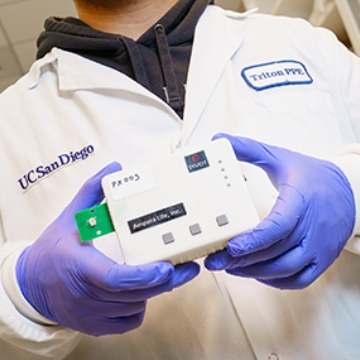A group of researchers around the globe have created a portable, non-invasive device capable of identifying biomarkers associated with Alzheimer’s and Parkinson’s disease
The biosensor can also transmit its findings wirelessly to a laptop or a smartphone making it invaluable to researchers and patients.
Device testing and accuracy
The research team tested the device on in vitro samples from patients and demonstrated that the device’s accuracy is comparable to current methods. The next phase in their plan involves assessing the biosensors with saliva and urine samples. There are potential modifications to adapting biomarkers associated with other medical conditions.
The devices utilise electrical detections rather than chemical methods; the researchers chose this method as it’s easier to implement and improves accuracy.
“This portable diagnostic system would allow testing at-home and at point of care, like clinics and nursing homes, for neurodegenerative diseases globally,” said Ratnesh Lal, a bioengineering, mechanical engineering and materials science professor at the UC San Diego Jacobs School of Engineering and one of the paper’s corresponding authors.
BY 2060, an estimated 14 million Americans will have Alzheimer’s Disease while other neurodegenerative like Parkinson’s are also increasing.
Currently, the leading testing method for Alzheimer’s and Parkinson’s requires invasive procedures such as spinal taps and imaging tests and MRI scans.
Device performance
This makes early detection challenging, as patients are often reluctant to undergo these procedures. Testing is challenging for symptomatic patients with mobility issues and those lacking access to local hospitals or medical facilities.
A prominent hypothesis in the field, which Lal has concentrated on, posits that Alzheimer’s Disease is triggered by the aggregation of soluble amyloid peptides into larger molecules, subsequently leading to the formation of ion channels in the brain.
Lal aimed to create a non-invasive test for Alzheimer’s and Parkinson’s biomarkers using electrical detections from saliva and urine. Preferring electrical over chemical methods for ease and accuracy, he developed a device to transmit results to patients’ families and physicians wirelessly.
The device is the outcome of Lal’s three decades of expertise and global collaboration with researchers, including those from Texas and China. “I am trying to improve quality of life and save lives,” he said.
“I am trying to improve quality of life and save lives,”
Technology transition
To achieve Lal’s goals, he modified a device created with his colleagues during the COVID-19 pandemic. This device was initially designed to detect spike and nucleoprotein proteins in the live SARS-CoV-2 virus, as detailed in their 2022 PNAS publication.
The success of this breakthrough was facilitated by chip miniaturisation and the widespread automation of biosensor manufacturing.
The 2023 PNAS study features a device with a chip housing and a highly sensitive graphene field-effect transistor (GFET). This transistor, consisting of a single-atom-thick graphene layer, has three electrode sources, a drain and a gate.
The gate electrode is linked to a single DNA strand, acting as a probe that selectively binds to amyloid beta, tau, or synuclein proteins.
This building alters the current flow between the source and the drain electrodes, providing a signal for detecting specific biomarkers like amyloids or COVID-19 proteins.
Clinical testing
The research team successfully tested the device on brain-derived amyloid proteins from deceased Alzheimer’s and Parkinson’s patients, demonstrating high accuracy comparable to existing methods, even at low concentrations. The device performed well with other proteins present, and though detecting tau proteins was challenging, combining results from the three biomarkers improved overall reliability.
The technology, now licensed to Ampera Life, led by Lal, is advancing to test blood plasma and cerebrospinal fluid, followed by saliva and urine samples in healthcare settings. Pending successful tests, Ampera Life aims to seek FDA approval within five to six months, targeting device availability within a year.








